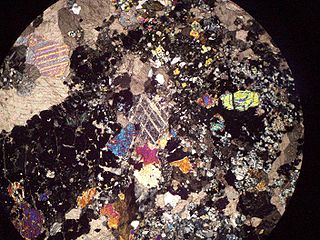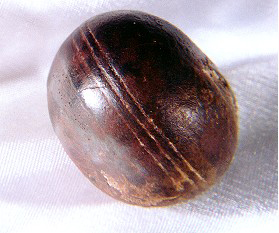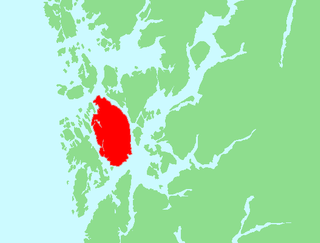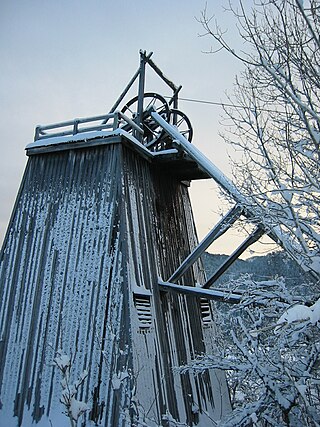 | |
| Location | |
|---|---|
| Setúbal | |
| Country | Portugal |
| Coordinates | 38°02′05″N008°25′32″W / 38.03472°N 8.42556°W |
| Production | |
| Products | pyrite |
| History | |
| Opened | 1900 |
| Closed | 1988 |
Lousal mine was a pyrite mine in Portugal. The mine was opened in 1900 and closed in 1988.
 | |
| Location | |
|---|---|
| Setúbal | |
| Country | Portugal |
| Coordinates | 38°02′05″N008°25′32″W / 38.03472°N 8.42556°W |
| Production | |
| Products | pyrite |
| History | |
| Opened | 1900 |
| Closed | 1988 |
Lousal mine was a pyrite mine in Portugal. The mine was opened in 1900 and closed in 1988.

Lazurite is a tectosilicate mineral with sulfate, sulfur and chloride with formula (Na,Ca)8[(S,Cl,SO4,OH)2|(Al6Si6O24)]. It is a feldspathoid and a member of the sodalite group. Lazurite crystallizes in the isometric system although well‐formed crystals are rare. It is usually massive and forms the bulk of the gemstone lapis lazuli.

The mineral pyrite ( PY-ryte), or iron pyrite, also known as fool's gold, is an iron sulfide with the chemical formula FeS2 (iron (II) disulfide). Pyrite is the most abundant sulfide mineral.

Limonite is an iron ore consisting of a mixture of hydrated iron(III) oxide-hydroxides in varying composition. The generic formula is frequently written as FeO(OH)·nH2O, although this is not entirely accurate as the ratio of oxide to hydroxide can vary quite widely. Limonite is one of the three principal iron ores, the others being hematite and magnetite, and has been mined for the production of iron since at least 2500 BP.

Skarns or tactites are coarse-grained metamorphic rocks that form by replacement of carbonate-bearing rocks during regional or contact metamorphism and metasomatism. Skarns may form by metamorphic recrystallization of impure carbonate protoliths, bimetasomatic reaction of different lithologies, and infiltration metasomatism by magmatic-hydrothermal fluids. Skarns tend to be rich in calcium-magnesium-iron-manganese-aluminium silicate minerals, which are also referred to as calc-silicate minerals. These minerals form as a result of alteration which occurs when hydrothermal fluids interact with a protolith of either igneous or sedimentary origin. In many cases, skarns are associated with the intrusion of a granitic pluton found in and around faults or shear zones that commonly intrude into a carbonate layer composed of either dolomite or limestone. Skarns can form by regional or contact metamorphism and therefore form in relatively high temperature environments. The hydrothermal fluids associated with the metasomatic processes can originate from a variety of sources; magmatic, metamorphic, meteoric, marine, or even a mix of these. The resulting skarn may consist of a variety of different minerals which are highly dependent on both the original composition of the hydrothermal fluid and the original composition of the protolith.

Acid mine drainage, acid and metalliferous drainage (AMD), or acid rock drainage (ARD) is the outflow of acidic water from metal mines or coal mines.

Vivianite (Fe2+
Fe2+
2(PO
4)
2·8H
2O) is a hydrated iron phosphate mineral found in a number of geological environments. Small amounts of manganese Mn2+, magnesium Mg2+, and calcium Ca2+ may substitute for iron Fe2+ in the structure. Pure vivianite is colorless, but the mineral oxidizes very easily, changing the color, and it is usually found as deep blue to deep bluish green prismatic to flattened crystals.
Vivianite crystals are often found inside fossil shells, such as those of bivalves and gastropods, or attached to fossil bone.

Pyrrhotite is an iron sulfide mineral with the formula Fe(1-x)S. It is a nonstoichiometric variant of FeS, the mineral known as troilite. Pyrrhotite is also called magnetic pyrite, because the color is similar to pyrite and it is weakly magnetic. The magnetism decreases as the iron content decreases, and troilite is non-magnetic. Pyrrhotite is generally tabular and brassy/bronze in color with a metallic luster. The mineral occurs with mafic igneous rocks like norites, and may form from pyrite during metamorphic processes. Pyrrhotite is associated and mined with other sulfide minerals like pentlandite, pyrite, chalcopyrite, and magnetite, and has been found globally.

The mineral marcasite, sometimes called “white iron pyrite”, is iron sulfide (FeS2) with orthorhombic crystal structure. It is physically and crystallographically distinct from pyrite, which is iron sulfide with cubic crystal structure. Both structures contain the disulfide S22− ion, having a short bonding distance between the sulfur atoms. The structures differ in how these di-anions are arranged around the Fe2+ cations. Marcasite is lighter and more brittle than pyrite. Specimens of marcasite often crumble and break up due to the unstable crystal structure.

The Fimiston Open Pit, colloquially known as the Super Pit, was Australia's largest open cut gold mine until 2016 when it was surpassed by the Newmont Boddington gold mine also in Western Australia. The Super Pit is located off the Goldfields Highway on the south-east edge of Kalgoorlie, Western Australia. The pit is oblong in plan view and is approximately 3.5 kilometres long, 1.5 kilometres wide and over 600 metres deep.

Klerksdorp spheres are small objects, often spherical to disc-shaped, that have been collected by miners and rockhounds from 3-billion-year-old pyrophyllite deposits mined by Wonderstone Ltd., near Ottosdal, South Africa. They have been cited by pseudoscientists and reporters in books, popular articles, and many web pages as inexplicable out-of-place artifacts that could only have been manufactured by intelligent beings. Geologists who have studied these objects have concluded that the objects are not manufactured, but are rather the result of natural processes.

Gersdorffite is a nickel arsenic sulfide mineral with formula NiAsS. It crystallizes in the isometric system showing diploidal symmetry. It occurs as euhedral to massive opaque, metallic grey-black to silver white forms. Gersdorffite belongs to a solid solution series with cobaltite, CoAsS. Antimony freely substitutes also leading to ullmannite, NiSbS. It has a Mohs hardness of 5.5 and a specific gravity of 5.9 to 6.33.
A framboid is a micromorphological feature common to certain sedimentary minerals, particularly pyrite (FeS2). The first known use of the term is ascribed to Rust in 1935 and is derived from the French 'la framboise', meaning 'raspberry', reflecting the appearance of the structure under magnification.

Patronite is the vanadium sulfide mineral with formula VS4. The material is usually described as V4+(S22−)2. Structurally, it is a "linear-chain" compound with alternating bonding and nonbonding contacts between the vanadium centers. The vanadium is octa-coordinated, which is an uncommon geometry for this metal.

The outflow of acidic liquids and other pollutants from mines is often catalysed by acid-loving microorganisms; these are the acidophiles in acid mine drainage.

Canavesite, Mg2(HBO3)(CO3)∙5H2O, is a rare carboborate mineral from the abandoned Brosso mine in Italy. Canavesite is a secondary mineral that occurs due to the weathering of ludwigite-magnetite skarn on the surface of mine walls. The physical properties consist of milky-white rosette-like aggregates of elongated transparent fibers shown in figure one. It has the crystal symmetry of a monoclinic with a diffraction symbol of 2/mP-/-.

Brukunga is a small town in the Adelaide Hills, located approximately 40 kilometres (25 mi) east of Adelaide and 4 kilometres (2.5 mi) north of the town of Nairne.
La Zarza mine is an abandoned mine near the town of La Zarza-Perrunal, Huelva, Andalusia, Spain. The deposit is part of the Spanish part of the Iberian Pyrite Belt. The orebody is 2,900 meters long and up to 100 meters thick. Like most of the volcanogenic massive sulfide ore deposit in the IPB it contains significant amounts of copper, zinc, lead, silver and gold.
The Mines of Aljustrel is a zinc/lead mine situated in the civil parish of Aljustrel e Rio de Moinhos, in the municipality of Aljustrel, in the Portuguese Alentejo district of Beja. It was classified as a monument in 1982.

Operation Cartoon was a British Commando raid on the island of Stord near Leirvik in Vestland, Norway on the night of 23/24 January 1943. The operation was carried out by 53 men of No. 12 Commando supported by ten men from the Norwegian 10 (IA) Commando. RAF Coastal Command co-operated with the Commandos, with aircraft from 18 Group.

The Løkken Mine is an underground pyrite mine located in the municipality of Orkland in Trøndelag, Norway. The mine was operative from 1654 to 1987, from the mining community Løkken Verk. It contained the largest deposits of its kind in Norway. Between 1654 and 1845, a total of 11,300 tons of copper was produced from the mine. From 1904 the mine was run by the company Orkla Grube-Aktiebolag, and until 1987 a total of 24 million tons of pyrite was produced from the mine. In addition to sulphur, the pyrite contained about 2% copper, in addition to zinc and traces of silver and gold. The products were originally transported to the sea by horse and sledge during winter time. From 1908 the ore was transported by the Thamshavn Line, which was the first electrical railway line in Norway. The annual production was about 350,000 tons of ore during its final years.